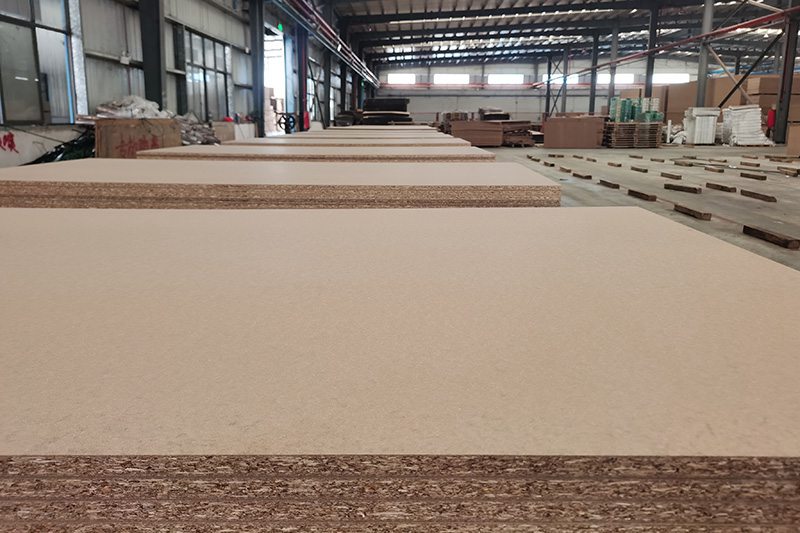Is Particle Board Toxic?
Particle Board isn’t “toxic” by default, but some boards can emit small amounts of chemicals—mainly formaldehyde and other VOCs—from the resins used to bind wood particles. Modern products made to recognized standards are engineered to keep those emissions very low. Whether a given panel is safe to bring home depends on the resin system, certification, where it’s used, how it’s finished, and how you handle/cut it. Below you’ll find a clear, practical guide.
1) What in particle board Could Be Harmful?
particle board (chipboard) is a panel made by pressing wood particles with thermoset resins under heat and pressure. The potential hazards don’t come from the wood itself; they come from binders, additives, and dust.
Resins and additives you’ll see:
Urea-formaldehyde (UF): Most common indoor binder historically. It can off-gas formaldehyde, especially when panels are new, warm, or damp. Cheap, high-emission UF is the source of most health concerns.
Melamine-urea-formaldehyde (MUF): Modified UF; stronger and generally lower emitting. Used for moisture-resistant (MR) or decorative laminates.
Phenol-formaldehyde (PF): Very durable; lower formaldehyde emissions than UF. Often used where moisture resistance matters.
MDI/PMDI (isocyanate-based): “NAF—No Added Formaldehyde” binder. Does not add formaldehyde as a raw ingredient and has very low emissions when fully cured.
Waxes & hydrophobic agents: Improve moisture resistance; typically low concern at trace levels.
Fire retardants/preservatives (less common): Used only in specialty grades; check SDS if specified.
What emissions are we talking about?
Formaldehyde: A volatile organic compound (VOC) that can irritate eyes, nose, and throat at elevated concentrations and can aggravate asthma. Emission rates depend on resin type, board density, manufacturing quality, temperature, and humidity.
Other VOCs: Small amounts of alcohols, aldehydes, or terpenes from wood and adhesives. Generally much lower than formaldehyde in modern boards.
Dust hazard (often overlooked):
Cutting/sanding particle board releases fine wood dust plus resin fragments. Wood dust is a respiratory irritant and a known occupational carcinogen with long-term overexposure. This is chiefly a fabrication/installation issue, not a day-to-day use issue.
2) Is Particle Board Toxic in Normal Use?
For finished furniture or cabinetry made from certified, low-emission boards, indoor exposures are typically well below health-based limits. Most major markets now require compliance with strict standards (e.g., CARB Phase 2 / EPA TSCA Title VI in the U.S.; E1/E0 classes in the EU; JIS/JAS F-star in Japan). These rules cap formaldehyde emissions from composite wood products and have pushed the industry toward low-UF, MUF, PF, or NAF/NAUF (No Added Urea Formaldehyde) formulations.
Think in terms of scenarios rather than absolutes:
| Scenario | What’s Happening | Relative Risk | Practical Notes |
|---|---|---|---|
| New, certified particle board furniture, sealed with laminate or veneer | Most emissions trapped; little exposed core | Low | Expect a “new furniture” odor that fades in days–weeks with ventilation. |
| Exposed raw edges, many square meters in a small room | More surface outgassing area | Low–Moderate | Seal edges to drop emissions and odors significantly. |
| Uncertified, very cheap boards with high-UF resins | Potentially higher formaldehyde emissions | Moderate | Avoid for bedrooms/nurseries; choose certified alternatives. |
| High temperature & humidity, poor ventilation | Emissions increase with heat/moisture | Moderate | Control indoor RH (~40–55%) and ventilate. |
| Fabrication phase: cutting/sanding without dust control | Airborne wood/resin dust | Elevated (acute) | Use dust extraction + P2/N95 respirator; this is the biggest short-term exposure. |
Key idea: toxicity is dose + duration. Modern, certified boards in a ventilated home contribute a small fraction of typical indoor VOC levels, especially once sealed and fully cured. The highest personal exposures tend to occur during cutting/installation—not long-term, normal use.
3) How to Choose and Use Particle Board Safely (Buyer & Builder Guide)
A. What to look for when buying
Certification labels:
CARB Phase 2 / EPA TSCA Title VI (North America)
E1/E0 emission class (EU)
F★★★★ (F-Four-Star) (Japan)
These indicate compliance with low formaldehyde emission limits verified by third-party testing.Resin declarations: Prefer NAF (No Added Formaldehyde; e.g., MDI) or NAUF (No Added Urea Formaldehyde). MUF/PF-modified boards are a good low-emission middle ground.
Product documentation: Ask for SDS and a Compliance/Emission statement from the supplier, especially for large projects or sensitive environments (schools, clinics).
B. Design & finishing moves that cut emissions
Seal exposed edges and cutouts. Use edge banding, water-borne polyurethane, shellac, or high-solids paint on raw edges. Edges are the biggest emitter; sealing them can dramatically reduce off-gassing and moisture uptake.
Laminate or veneer both faces of shelves/panels to balance and seal the board. Balanced construction also reduces warp.
Use low-VOC adhesives/finishes. The wrong contact cement or solvent varnish can add more VOCs than the board itself. Choose low-VOC or water-borne systems.
C. Installation practices (where most exposure happens)
Cut with dust extraction (track saw or table saw with HEPA vac). Sand with vac-attached random-orbit sander.
PPE: Wear a P2/N95 (or better) respirator, safety glasses, and gloves when cutting/sanding.
Ventilate and clean up. Wet-wipe or HEPA-vacuum dust; don’t dry sweep. Dispose of offcuts per local rules.
D. Indoor air management after delivery
Off-gas & ventilate: Unbox in a ventilated area. Let panels acclimate with windows open or HVAC on fresh-air mode.
Control humidity: Keep indoor RH ~40–55%; both emissions and odor increase at higher RH/temperature.
Air purifiers: HEPA + activated carbon units help reduce particulates and adsorb VOCs during the first weeks.
4) FAQs, Myths vs. Facts, and Practical Alternatives
“All particle board is toxic.” – False.
Modern boards certified to CARB/TSCA or E1/E0 have low emissions. The resin choice and edge sealing dictate real-world exposure far more than the fact it’s particle board.
“Formaldehyde off-gassing never stops.” – Misleading.
Emissions decline over time, fastest in the first days–weeks. Proper sealing and ventilation reduce both intensity and duration.
“Moisture-resistant (MR) boards are always low-emission.” – Not automatically.
MR relates to swelling and durability, not necessarily emissions. Many MR boards do use better resins (e.g., MUF), but you still want explicit emission certification.
“NAF boards contain no formaldehyde at all.” – Clarify.
NAF means no formaldehyde is added in the adhesive. Wood naturally contains tiny amounts of formaldehyde; emissions are still very low and typically lower than standard UF/MUF panels.
Alternatives if you’re highly sensitive:
NAF particle board (MDI-bonded) or NAUF products.
Exterior-grade plywood (phenolic-bonded) with verified low emissions.
Solid wood finished with low-VOC oils/varnishes.
Whatever you choose, finish/seal all faces and edges and ventilate during cure.
Conclusion
Particle board can be used safely in homes, offices, and schools when you choose certified, low-emission products, seal exposed edges, and manage dust during fabrication. The biggest health risk isn’t a cabinet quietly sitting in a room; it’s cutting and sanding without dust control. If you need the lowest possible emissions, select NAF/NAUF or CARB/TSCA-compliant boards, finish them well, and ventilate. Do that, and particle board is a cost-effective, low-emission component of modern interior construction rather than a toxic liability.
Previous:


